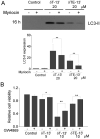Vitamin E metabolite 13'-carboxychromanols inhibit pro-inflammatory enzymes, induce apoptosis and autophagy in human cancer cells by modulating sphingolipids and suppress colon tumor development in mice
- PMID: 27016075
- PMCID: PMC4867259
- DOI: 10.1016/j.freeradbiomed.2016.03.018
Vitamin E metabolite 13'-carboxychromanols inhibit pro-inflammatory enzymes, induce apoptosis and autophagy in human cancer cells by modulating sphingolipids and suppress colon tumor development in mice
Abstract
Vitamin E forms are substantially metabolized to various carboxychromanols including 13'-carboxychromanols (13'-COOHs) that are found at high levels in feces. However, there is limited knowledge about functions of these metabolites. Here we studied δT-13'-COOH and δTE-13'-COOH, which are metabolites of δ-tocopherol and δ-tocotrienol, respectively. δTE-13'-COOH is also a natural constituent of a traditional medicine Garcinia Kola. Both 13'-COOHs are much stronger than tocopherols in inhibition of pro-inflammatory and cancer promoting cyclooxygenase-2 (COX-2) and 5-lipoxygenase (5-LOX), and in induction of apoptosis and autophagy in colon cancer cells. The anticancer effects by 13'-COOHs appeared to be partially independent of inhibition of COX-2/5-LOX. Using liquid chromatography tandem mass spectrometry, we found that 13'-COOHs increased intracellular dihydrosphingosine and dihydroceramides after short-time incubation in HCT-116 cells, and enhanced ceramides while decreased sphingomyelins during prolonged treatment. Modulation of sphingolipids by 13'-COOHs was observed prior to or coinciding with biochemical manifestation of cell death. Pharmaceutically blocking the increase of these sphingolipids partially counteracted 13'-COOH-induced cell death. Further, 13'-COOH inhibited dihydroceramide desaturase without affecting the protein expression. In agreement with these mechanistic findings, δTE-13'-COOH significantly suppressed the growth and multiplicity of colon tumor in mice. Our study demonstrates that 13'-COOHs have anti-inflammatory and anticancer activities, may contribute to in vivo anticancer effect of vitamin E forms and are promising novel cancer prevention agents.
Keywords: Apoptosis; Autophagy; Cancer; Sphingolipid; Vitamin E metabolites.
Copyright © 2016 Elsevier Inc. All rights reserved.
Figures






Similar articles
-
Natural Forms of Vitamin E as Effective Agents for Cancer Prevention and Therapy.Adv Nutr. 2017 Nov 15;8(6):850-867. doi: 10.3945/an.117.016329. Print 2017 Nov. Adv Nutr. 2017. PMID: 29141970 Free PMC article. Review.
-
Different forms of vitamin E and metabolite 13'-carboxychromanols inhibit cyclooxygenase-1 and its catalyzed thromboxane in platelets, and tocotrienols and 13'-carboxychromanols are competitive inhibitors of 5-lipoxygenase.J Nutr Biochem. 2022 Feb;100:108884. doi: 10.1016/j.jnutbio.2021.108884. Epub 2021 Oct 25. J Nutr Biochem. 2022. PMID: 34710615 Free PMC article.
-
Natural forms of vitamin E and metabolites-regulation of cancer cell death and underlying mechanisms.IUBMB Life. 2019 Apr;71(4):495-506. doi: 10.1002/iub.1978. Epub 2018 Dec 11. IUBMB Life. 2019. PMID: 30548200 Review.
-
Metabolism of natural forms of vitamin E and biological actions of vitamin E metabolites.Free Radic Biol Med. 2022 Feb 1;179:375-387. doi: 10.1016/j.freeradbiomed.2021.11.012. Epub 2021 Nov 14. Free Radic Biol Med. 2022. PMID: 34785321 Free PMC article.
-
Gamma-tocotrienol profoundly alters sphingolipids in cancer cells by inhibition of dihydroceramide desaturase and possibly activation of sphingolipid hydrolysis during prolonged treatment.J Nutr Biochem. 2017 Aug;46:49-56. doi: 10.1016/j.jnutbio.2017.04.003. Epub 2017 Apr 12. J Nutr Biochem. 2017. PMID: 28456081 Free PMC article.
Cited by
-
Vitamin E and cancer prevention: Studies with different forms of tocopherols and tocotrienols.Mol Carcinog. 2020 Apr;59(4):365-389. doi: 10.1002/mc.23160. Epub 2020 Feb 3. Mol Carcinog. 2020. PMID: 32017273 Free PMC article. Review.
-
Natural Forms of Vitamin E as Effective Agents for Cancer Prevention and Therapy.Adv Nutr. 2017 Nov 15;8(6):850-867. doi: 10.3945/an.117.016329. Print 2017 Nov. Adv Nutr. 2017. PMID: 29141970 Free PMC article. Review.
-
Vitamin E and Metabolic Health: Relevance of Interactions with Other Micronutrients.Antioxidants (Basel). 2022 Sep 9;11(9):1785. doi: 10.3390/antiox11091785. Antioxidants (Basel). 2022. PMID: 36139859 Free PMC article. Review.
-
Appraising the role of circulating concentrations of micro-nutrients in epithelial ovarian cancer risk: A Mendelian randomization analysis.Sci Rep. 2020 Apr 30;10(1):7356. doi: 10.1038/s41598-020-63909-5. Sci Rep. 2020. PMID: 32355161 Free PMC article.
-
α-Tocopherol-13'-Carboxychromanol Induces Cell Cycle Arrest and Cell Death by Inhibiting the SREBP1-SCD1 Axis and Causing Imbalance in Lipid Desaturation.Int J Mol Sci. 2023 May 25;24(11):9229. doi: 10.3390/ijms24119229. Int J Mol Sci. 2023. PMID: 37298183 Free PMC article.
References
-
- Jemal A, Bray F, Center MM, Ferlay J, Ward E, Forman D. CA Cancer J Clin. United States: 2011. Global cancer statistics; pp. 69–90. - PubMed
-
- Moya-Camarena SY, Jiang Q. The role of vitamin E forms in cancer prevention and therapy - Studies in human intervention trials and animal models. In: Sarkar FHE, editor. Nutraceuticals and Cancer. Springer Science Business Media B.V.; 2011. pp. 323–354. http://dx.doi.org/310.1007/1978-1094-1007-2630-1007_1015.
Publication types
MeSH terms
Substances
Grants and funding
LinkOut - more resources
Full Text Sources
Other Literature Sources
Medical
Research Materials

